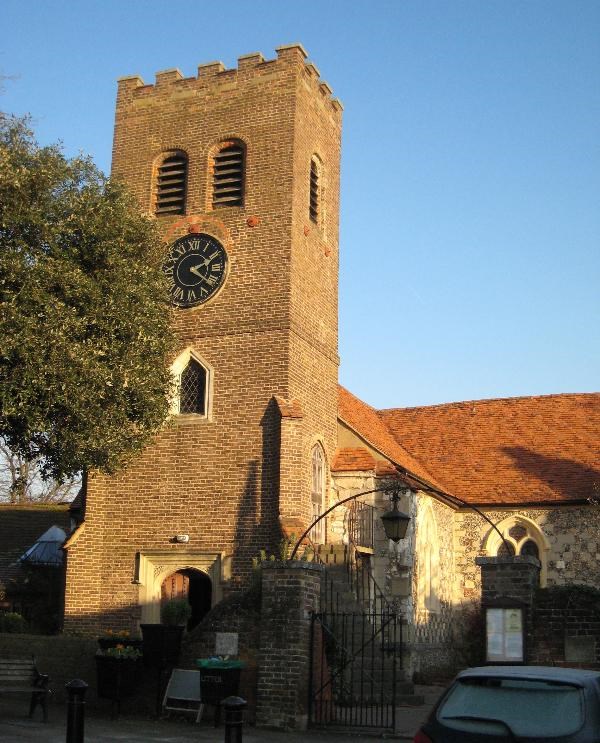Church Micro 425. St. Nicholas' Shepperton. Multi-cache
Long Man: As the owner has not responded to my previous log requesting that they check this cache, I'm archiving it.
Andy
Long Man
Volunteer UK Reviewer - Geocaching.com
Geocaching.com Guidelines
Geocaching.com Help Centre
UK Geocaching Information
Church Micro 425. St. Nicholas' Shepperton.
-
Difficulty:
-

-
Terrain:
-

Size:  (other)
(other)
Please note Use of geocaching.com services is subject to the terms and conditions
in our disclaimer.
If anybody would like to expand this series please do, we would just ask that you could let sadexploration know first so he can keep track of the Church numbers and names to avoid duplication.

The co-ordinates given are for the front gates to the church. The name Shepperton is derived from 'Shepherd's Town' and the name of one of the older streets, Sheep Walk, still reflects that origin. Shepperton was mentioned in the Domesday Book of 1086 and was called Scepertone. St. Nicholas' Church is situated in an area called Church Square, it is next to the river and was the original site of the village. When a railway station was opened on the 1st November 1864 a mile to the North, it linked Shepperton to London's Waterloo station, the village expanded in that direction and is now centered around the station. A church has stood on this site since the 7th century. The early church would have made from wood and thatched with reeds. The monks from nearby Chertsey Abbey may have originally ministered to the villagers, but the entry for Shepperton in the Doomsday Book does include a priest. In the 12th century a more solid structure of stone and flint was built. In 1605-6 high floods inundated the church. Some timber and stone were salvaged and incorporated into the present building which was completed in 1614. Around Church Square at Old Shepperton (shepherds' settlement), is a prime example of village survival. Although some of the original foundations are still thought to be in place. North of the church is the rectory. Parts of the Rectory date from the 15th century. The excellent Queen Ann front was added around 1700. A hundred years later the Reverend Lewis Atterbury, at the suggestion of Queen Anne, added the tower. This is built in Thames Valley brick, contrasting with the rest of the building, which is in a chequered design of stone blocks alternating with squares of flint rubble. The clock was placed in the tower in 1769. The rectangular bell tower was added in the early 18th century. The tower contains six bells, five of them dating from 1877 and the smallest bell named Little Nicholas was installed in 1980, when the tower was strengthened. There is an external staircase leading to the gallery, added in 1834. There is another external staircase leading to the smaller Manor House Gallery over the baptistry. This enabled the Lord of the Manor to cut across the fields from the Manor House and enter his own pew without having to mix with the rest of the congregation. From this vantage point he could also keep a watchful eye on the Rector! The choir and clergy vestries on the south side were added in 1934. It is noticeable that the chancel and the nave are not quite in alignment - this could have been an error by the architect or maybe the builder. The pews are called "box pews" and date from the 19th century. On the gallery is a coat of arms painted directly on to the panelling. It is the Hanoverian Royal Arms, probably those of William IV. There are many reminders of past worshippers in the church, the stained glass windows, stone and brass tablets and war memorials. The chancel screen, reredos, choir and clergy stalls, along with the glass screens at the back of the church and the gallery, were all given by relations and friends in grateful memory of past parishioners. The organ is a Bishop organ installed in 1908. Originally a choirboy was paid one old penny to work the bellows for each service. Like with many old buildings there are stories of ghosts. In this case the ghost is said to be Erasmus, 15th century Dutch renaissance scholar, a friend of William Grocyn, Rector of Shepperton from 1504 - 1513.
The Task At one side of the St. Nicholas Church is the solitary grave of Margaret Love Peacock. She was the daughter of Thomas Love Peacock and died when still young. Peacock wrote a poem to his baby daughter which he had inscribed on a headstone on the grave. Find the headstone of Maragaret Love Peacock and fill in the year that she was born (1825) and the year she died (EFGH) into the equation. The final location can be found at: N51° 23.(8-H)(5+G)(1+E) W000° 27.(FxG+E)(2+1) There is a nano to be found if you stand with the wall to your back, look right and pick the taller of the two, but it only holds a log, no pen or pencil (please bring one) The area is full of muggles and very over looked on all sides so extreme stealth is required.
Try hard to find metal for it to hang on to.
IMPORTANT You might want to avoid the opening times for the two / three pubs (hotels) and Saturdays at peak wedding times, Sunday mornings around service time. It can get very busy around this area and parking could be a problem. Alternative parking can be found at Manor Park Car Park which will soon be pay and display. NB. This is the third cache at this spot, if this goes, so does GZ to a new location.
Please be aware there is water near by so please keep an close eye on your young children.
Additional Hints
(Decrypt)
Haqrearngu naq svkrq jvgu n zntarg vf gur pnpur.